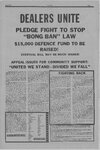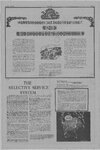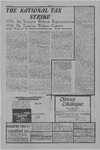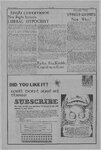| OCR Text |
Show DESERET REEFER March NNARIIUANA eee FREEDOM IS HE ISSUE. Condensed and reprinted from an article by Jeff Riggenbach originally printed in the Libertarian Review. “part The fact is that the “‘health issue” is hardly worth discussing. It’s a phony, a red herring, from beginning to end. There is not now and never has been any reputable evidence to support the claim that marijuana use is harmful to the health. . The regular inhalation of smoke The any burning substance is capable of causing various upper respiratory diseases, including lung cancer, but ‘this problem is easily avoided by tens of milMinor who eat the drug in cookies and sweetmeats instead of smoking it. No one has ever succeeded in establishing the likelihood of any other serious health problems resulting from marijuana use. And there have been many attempts. Contrary to the frequent assertion that “‘the evidence isn’t yet all in on marijuana, it hasn’t yet been studied enough to be given a clean bill of health’’, the ‘evidence is all in. We will doubtless learn more in the future about the effects of the hemp plant upon human users, but we know all we need to know right now to say that marijuana is one of the least toxic substances known to modern medicine. , is often said,’ wrote Edward Brecher ee The Panama Canal Zone Military Inves- tigations, conducted by the US Army from 1916 to 2939 and reported in the Military Surgeon in 1933. According to Lester Grinspoon (in Mari- juana Reconsidered, Harvard University Press, 1971), the Army found it was “not possible to demonstrate any evidence of mental or physical deterioration” in users. (3) The 1939-1944, LaGuardia Committee Report of prepared by 8 physicians, a psycholo- gist, and four New York City health officials, at the request of New York (City Mayor Fiorello LaGuardia, who wanted to get to the bottom of _ “The Marijuana Problem in the City of New York” (as the committee ultimately entitled its report). The LaGuardia Committee found that “those who have been smoking marijuana for a period of years showed no mental or physical deterioration which may be attributed to the drug”. (4) The Baroness Wooton '. prepared by a special - visory Committee on Report of 1968, subcommittee of the AdDrug Dependence of the - United Kingdom Home Office. As Breecher - puts it, the report of the subcommittee “confirm- ed in all substantial respects the findings of the -. Indian Hemp Drugs Commission, the tional Institute on Drug Abuse” as declaring that parents are mobilizing because they “‘are quite convinced that marijuana is a harmful and unsafe drug and is particularly dangerous when used by children.” : And where are these “disturbing new findings” which prove “‘the illeffects of heavy smoking on children’s minds and bodies’’? They are, say the parents’ groups, in the newest NIDA report on marijuana, which was published last year and widely publicized in January when its findings were presented before US Senate hearings. Yet there is nothing new in this report (except, here and there,a new low in scientific method, as when US Army doctors report that heavy marijuana users develop abrormal cells in their lungs, basing this conclusion on their study of a group of smo_ kers, almost all of whom were also heavy cigarette smokers!) For the most part, the report mere— ly rehearses the most recent medical findgins and fairly bends over backward to avoid over-generalizing from them. “Throughout the drug instr Panama - Canal Zone investigations, and the LaGuardia * Commytee reper. (p. 452) __A5) = =The Final Report of the Canaaian Government's LeDain Commission, published in 1972. The Commission found that the short- is.smokers has been carried out Again, ' Rica. as in Jamaica, ...no tion of young lives and growing Bae: for law) caused by the present use of the criminal Another intensive study, clinical in orientation, was conducted by a multidisciplinary team at the University of Athens. The results of this research on Athenian workers confirm both the costa Rican and Jamaican findings on all comparable variables. : The Drug Abuse Council found that “mari juana use in moderate amounts over a short term THE HYPOTHESIS THAT USE PRECIPITATES AN SYNDROME”. | poses far less of a threat to an individual’s health than does indiscriminate use of alcohol and tobacco”, and went on to comment: Millions of dollars have been invested by public and private sources to determine what effects marijuana might be having on the growing number — of users; since 1972 the US government alone has given over $25 million in grants for research on marijuana. The National INstitute on rey (NIDA), the federal watchdog agency on rug use and misuse, has issued six reports since 1971 summarizing the hundreds of research reports which have been published during that eriod. It is significant that research reports by NIDA have not concluded that marijuana poses a major public health hazard, though NIDA P. ne cifically stated that it feels a duty to call public attention to certain potentially adverse consequences to its continued use. It is also significant “THE INDIVIDUAL AND SOCIAL HARM (INCLUDING THE DESTRUCTION OF YOUNG LIVES AND GROWING DISRESPECT FOR THE LAW) CAUSED BY THE PRESENT USE OF THE CRIMINAL LAW TO ATTEMPT TO SUPPRESS CANNABIS FAR OUTWEIGHS ANY POTENTIAL FOR HARM WHICH CANNABIS COULD CONCEIVABLY POSSESS.” Final Report of the Canadian Government’s ission. LeDain only The 1972 final report for the National Commission on Marijuana and Drug Abuse(the Shafer Commission), nine of whose 13 members were appointed personally by then-President Richard Nixon; the 1975 Report of the Research the Comm- around the network of parent entitled), undertaken in 1970 with the sponsorship of the Center for Studies of Narcotic and May, SRL Re ea a (The Facts About few years’, nation.” ‘The groups first opposed the New nationwide to drugs has been formed’’, the Los Angeles Times reported in “*. . .to inform TT IE i and educate TR UR SE parents, adolesa SA But the young these days are, if not exactly a political, then very nearly that; The overwhelming majority of the baby boom babies who grew up to become the dope smoking flower children only when they’re stoned). As we One won- ject their parent’s values. Drug use is more often a symptom than a York Times reported, “hundreds of. . . antipot parent’s organizations have sprung up, unheralded, Institute for the Study of Man on its two year study of Ganja in Jamaica (as the report was RSP last Michigan study of the class of ’76 makes it 61.7%. about the health of our children. (It might. well be cause for alarm, on the other hand, about the state of a public school system. whose charges find and toward the family in particular.” every other year instead of annually “During in itself necessarily a cause for alarm — at least ders whether the real issue here is marijuana at all — orintsead a growing tendency on the part of American children (especially the children of more traditional, authoritarian parents) to re- which indicates that extreme concern over mart ties”. patrick, William F. Buckley, Jr., and even, would you believe it, Ann Landers and Art Linkletter. Public opinion is one thing, of course; political action is another. And the future of successful marijuana activism, like the future of every thing else, lies with the young. The young favor abolishing marijuana pronibition, make no mistake about that: 50% of college freshmen advocate exactly that according to Gallup; a University of show some of the typical side effects of heavy smoking — the loss of interest in schoolwork, the changed emotional set toward life in general Yet, it is not receding everywhere at-once, and in some places it is advancing. “A vociferous new anti-marijuana crusade’, Newsweek has -reported, “is forming up around the country, spurred by alarmed parent groups and drug authori- published: of Churches, the American Civil Liberties Union, and Consumer’s Union, and such prominent conservatives of the sort you’d never expect to see ‘with anger and fear when their children start to that now NIDA is required to produce a marijuana er can Academy of Pediatrics, the National Countil HEAVY CANNABIS ‘AMOTIVATIONAL’ have seen, lifelong heavy smokers of marijuana in of the 60s and the dope smoking “‘Me Decade” India, Jamaica, Costa Rica, and Greece have been _ narcissists of the 70s have never participated in an found in varying studies conducted over the en- election of even registered to vote. They’ve been tire past century to exhibit no physical or mental asked why, and they’ve replied that they’ve had pathologies which are not also exhibited by memnothing to vote for, that they’ve been effectively bers of non-marijuana-using control groups and disenfranchised by both the Republicans and the which may also be unequivocally attributed to Democrats — as, in fact, they have. Why else marijuana use. There is nothing in the new NIDA would the majority of those who have recently report to cast these findings in any new doubt. One wonders if the New York Times didn’t hit the nail precisely (if inadvertantly) on the head “ONE WONDERS WHETHER THE REAL ISSUE when it announced that “parents, whether or not HERE IS MARIJUANA AT ALL — OR INSTEAD they themselves have smoked pot, tend to react ceivably possess.” (Brecher, pp. 464-466). orts that only a minority of Americans, 41% still may distort public perception of the facts by implying that there is in fact damage to all these (New York Times, October 19, vital systems.” 1979). | The new NIDA report does contain one new fact, however: the fact that the number of school-age daily marijuana smokers has doubled in the last five years. As we have seen, this is not it tolerable to Congress juana use may be receding. “Drug Abuse”, p. 165). Since Brecher wrote nearly a decade ago, three more such authoritative studies have been ter of the University of Chicago reports that 34% of American adults now favor removing all criminal penalties from marijuana. Only 12% felt that way ten years ago. The Gallip organization rep- coming out for “drug addiction’, as James J. Kil- law to attempt to suppress cannabis far outweighs any potential for harm which cannabis could con- for abolishing marijuana prohibition? In the United States, marijuana is slowly becoming a political cause celebre. The process, however, is unsteady and proceeds in fits and starts, and in such a way that at least six inches of ground is lost for every foot that is gained. Still, the overall direction is right and progress is undeniable. The National Opinion Research Cen- 7a Pay term physiological effects of marijuana smoking “‘are usually slight and apparently have little clini- cal significance’, and that in the long term, ‘‘the individual and social harm (including the destruc- Ca ee believe three ought to be criminal penalties of any kind for simple possession of marijuana. In California, where penalties for possession of small sive fedical examination. The results of psychoamounts have been reduced for the past four tute’s report on human effects”, wrote the New logical and brain function tests indicated that years, only 36% of the people favor returning to York Time’s Harold M. Schmeck, Jr. on the “chronic marijuana use is not associated with the earlier, harsher system. Forty-two percent of permanent or irreversible impairment in higher occasion of its original publication, “the words Californians now favor abolishing penalties for ‘contradictory,’ ‘uncertain’, ‘unevaluated’, and cultivation and sale as well. Only 13% of Califorbrain functions or intelligence”. The Costa ‘unconfirmed’, run like a minor theme. ‘A contiRica project also ode the examination of nians felt that way a decade ago. (All California nuing problem throughout the past decade has testosterone levels and immunology as related to figures are from the Field Research Corporation). cannabis use, areas of research not undertaken in — been the tendency to overinterpret preliminary In Maines, another experienced “decriminalization”’ research findings’, said the report. Schmeck the Jamaica study. No eae between maristate, 68% of the people favor keeping the present himself cautioned against a related problem. “The juana use and testosterone levels s was found nor law or reducing penalties even further. And were there indications of impaired immunological ' yery fact’, he wrote, “‘that a long list of possible according to the National Organization for the response. Significantly, the study established that effects of marijuana on the body can be drawn ~Reform of Marijuana Laws (NORML), the remothe use of cannabis did not impair the meets ~ : val of all criminal penalties for the private posses- = ability to function well at home or at work and sion and use of marijuana has now been endor=ec no evidence was found to support the hypothesis by the American Medical Association, the Amerithat heavy cannabis use precipitates an “amotiva — “, . . THE STUDY ESTABLISHED THAT THE can Bar -Association, the American Psychiatric USE OF CANNABIS DID NOT IMPAIR THE tional syndrome”. As in Jamaica, marijuana is Association, the National Association for Mental SUBJECT’S ABILITY TO FUNCTION WELL... utilized in Costa Rica to cope with the exigencies Health, the American Public Health Association, of daily life, not to withdraw from society. AND NO EVIDENCE WAS FOUNDTO SUPPORT the National Education Association, the Ameriin Costa evidence of pathology could be found after exten- . “,.. WE KNOW ALL WE NEED TO KNOW... TO SAY THAT MARIJUANA IS ONE OF THE LEAST TOXIC SUBSTANCES KNOWN TO MODERN MEDICINE”. class, chronic canna “THE VERY FACT. . .THAT A LONG LIST OF POSSIBLE EFFECTS OF MARIJUANA ON THE BODY CAN BE DRAWN MAY DISTORT PUBLIC PERCEPTION OF THE FACTS BY IM.- » PLYING THAT THERE IS IN FACT DAMAGE TO ALL THESE VITAL SYSTEMS.” of the ill effects of heavy smoking on children’s minds and bodies’’,says the New York Times, “ has added fuel to the anti-pot fire’. And the Los Angeles Times quotes a ‘“‘spokesman for the Na- Under the auspices of the University of Florida, amedical anth mpsloicgied study of urban, working- Englishmen and three Indians, including one rajah. They studied marijuana users who had been using from childhood and found that “small doses of hemp were beneficial’’ and that moderate use, “‘even if regular, had no significant injurious mental, physical; or moral effect.”? (Michael: R. Aldrich, A Brief Legal History of Marijuana, Do It Now Foundation, 1971, p. 12) They concluded that “total prohibition of the cultivation of the hemp plant for narcotics, and of the manufacture, sale, or use of the drugs derived from it, is neither necessary nor expedient in consideration of their ascertained effects.”’ (Volume I, p. 264 (2) any further, that such a finding was routine for studies : eee “that penalties Why are all these parents up in arms% What of its type: the US, by a British commission of seven — four eae found So it is. And we should by rights be just as free to grow it and buy it and sell it and smoke it and do whatever we want with it as we are to grow and buy and sell and satisfy ourselves with anything esle that grows out of the ground, be it com or tobacco, or grapes. But what are the prospects about the dangers has given rise to this new national movement? “At its core’, says Newsweek, “is a genuine concern, based on disturbing new findings.”’ “The recent and dramatic increase in public awareness 162) The Research Institute for the Study of Man found that the state of physical health of a group of average Jamaican laborers who were heavy daily smokers of marijuana (and in most cases had been since childhood) was virtually indistinguishable from the state of physical health of acontrol group of non-marijuana users — and © (1) The Indian Hemp Drugs Commission Report of 1894, a 3,281-page, seven-volume document, prepared in India, where marijuana use has been for centuries what coffee drinking is in ae Commission others “to fight efforts to remove criminal for marijuana offenses.” | ae “(THE ARMY FOUND THAT) IT WAS NOT POSSIBLE TO DEMONSTRATE ANY EVIDENCE OF MENTAL OR PHYSICAL DETERIORATION IN USERS OF MARIJUANA. . .” | nearly a decade ago, “that little is known about the psychological and physiological effects of marijuana on the human user. This isa simple error of tact. In addition to many hundreds of significant papers reporting marijuana research through the last century, an impressive series of official investigating bodies have reviewed all of the available evidence and have presented their findings at length”’. Brecher lists as ‘“‘the most important of these official marijuana investiga- tion reports’ the following five: Shafer and of marijuana and other mind altering drugs’ and risk of harm probably lay in the heavy, long-term ‘use of the drug — although it lacked evidence even on this risk”. (The Facts About “Drug Abuse’’* p. lions of regular marijuana users in India and Asia “It cents,and children Drug Abuse and the National Institute of Mental al Health; and the 1980 Final Report of the privately funded, Washington-based Drug Abuse Council, which spent seven years researching (as it called its 291 page Final Report)“The Facts About ‘Drug Abuse’ ”’. from Page 5 1981 NE cause of rebellious attitudes, which is why harsher enforcement of laws against drugs only serves to reinforce rebellion and never succeeds in stamping it out. When Japanese officials imprisoned Paul McCartney for ten days early last year for bringing slightly less than half a pound of marijuana into their country (he was passing through customs after arriving for an extended Japanese tour) they touched off world-wide protest, especially among the young people who are supposedly the beneficiaries of Japan’s harsh anti-marijuana laws. To these young people, McCartney was a culture hero made a martyr to one of their causes. As Linda McCartney told the Los Angeles Times after Paul had been released from jail, had cancelled his tour and had returned to England, the Japanese ‘‘made a great fuss over such a little thing. My goodness, marijuana — it’s just something that grows out of the ground.” EY EB DR SET A RE AI — A GROWING TENDENCY ON THE PART OF AMERICAN CHILDREN (ESPECIALLY THE CHILDREN OF MORE TRADITIONAL, AUTHORITARIAN PARENTS) TO REJECT THEIR PARENT'S VALUES.” been registering to vote as Libertarians be 25-40 year olds who have never before registered to vote because there has never before been a genuinely viable, genuinely major third party to represent them? | | Those of the baby boom generation for whom marijuana is a major, top priority political issue — which is to say, about half ot the estimated ten million daily US smokers and few hundred thousand others from here and there — have been especially neglected by the Republicans and Democrats. A great many of those in the marijuana movement remain apolitical, of course. Many of the most politically-oriented of them are Yippies or others whose concept of political action to achieve legal marijuana goes no further than playing “dirty tricks” on the “ruling class’ and . disrupting its operations, sowing disorder and. chaos in their wake. But more and more of them are coming to realize that if they want in the near future to get rid of the laws which threaten their businesses, AS ASI AS AAR force them SESE to pay outrageous | |













